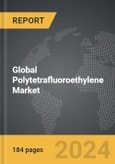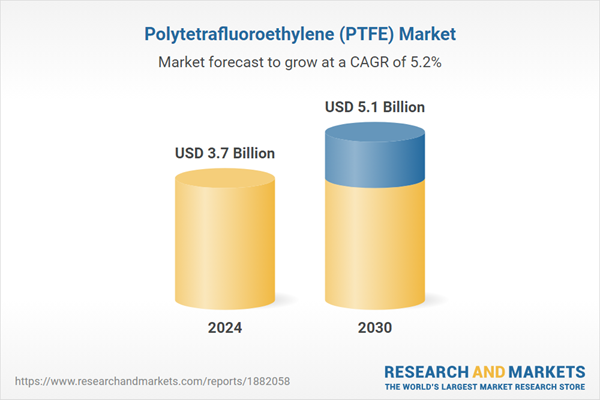The global market for Polytetrafluoroethylene (PTFE) was valued at US$3.7 Billion in 2024 and is projected to reach US$5.1 Billion by 2030, growing at a CAGR of 5.2% from 2024 to 2030. This comprehensive report provides an in-depth analysis of market trends, drivers, and forecasts, helping you make informed business decisions. The report includes the most recent global tariff developments and how they impact the Polytetrafluoroethylene (PTFE) market.
In the automotive industry, PTFE is used in various components such as gaskets, seals, and bearings due to its ability to withstand high temperatures and corrosive fluids. Its non-stick and low-friction properties are also leveraged in the production of high-performance automotive parts, reducing wear and improving efficiency. In the electronics sector, PTFE is valued for its excellent dielectric properties, making it a preferred material for insulating cables and wiring in high-frequency applications. The chemical processing industry benefits from PTFE's resistance to corrosive substances, using it to line pipes, valves, and tanks to prevent chemical degradation. Additionally, PTFE's biocompatibility and inertness make it suitable for medical applications, including surgical implants and devices. Its use in filtration systems, thanks to its hydrophobic nature, helps in the creation of membranes that can filter particulates without absorbing water, making it valuable in both industrial and environmental applications.
The growth in the PTFE market is driven by several factors. Technological advancements in manufacturing processes have increased the efficiency and quality of PTFE products, expanding their applications. The rising demand from the automotive industry, driven by the need for durable, high-performance materials, is a significant factor propelling market growth. The expanding electronics industry, especially with the growth of high-frequency and high-performance electronic devices, has also increased the demand for PTFE due to its superior insulating properties. Furthermore, the chemical processing industry's continuous need for materials that can withstand harsh chemicals without degrading has fueled the demand for PTFE linings and components. The healthcare sector's growing reliance on biocompatible materials for medical devices and implants is another critical driver. Moreover, the push towards sustainability and eco-friendly materials has led to innovations in PTFE recycling and waste management, making it a more attractive option for various industries. As these trends continue to evolve, the PTFE market is expected to see robust growth, supported by ongoing innovations and the expanding scope of its applications across different sectors.
Segments: Form (Granular, Fine Powder, Dispersion, Micronized); End-Use (Chemical & Industrial Processing, Electronics & Electrical, Automotive & Aerospace, Consumer Goods, Other End-Uses).
Geographic Regions/Countries: World; United States; Canada; Japan; China; Europe (France; Germany; Italy; United Kingdom; Spain; Russia; and Rest of Europe); Asia-Pacific (Australia; India; South Korea; and Rest of Asia-Pacific); Latin America (Argentina; Brazil; Mexico; and Rest of Latin America); Middle East (Iran; Israel; Saudi Arabia; United Arab Emirates; and Rest of Middle East); and Africa.
The analysts continuously track trade developments worldwide, drawing insights from leading global economists and over 200 industry and policy institutions, including think tanks, trade organizations, and national economic advisory bodies. This intelligence is integrated into forecasting models to provide timely, data-driven analysis of emerging risks and opportunities.
Polytetrafluoroethylene (PTFE) - Key Trends and Drivers
Polytetrafluoroethylene (PTFE) is a highly versatile synthetic fluoropolymer known for its exceptional chemical resistance, non-stick properties, and high-temperature tolerance. Discovered accidentally by Roy Plunkett in 1938 while working for DuPont, PTFE has since become a critical material in various industrial applications. Its unique properties, including a low coefficient of friction and resistance to almost all chemicals, make it an ideal choice for a wide range of uses. PTFE is most commonly recognized by the brand name Teflon, particularly in the context of non-stick cookware, but its applications extend far beyond the kitchen. It is widely used in the aerospace, automotive, electronics, and chemical processing industries, where durability and performance under extreme conditions are paramount. PTFE's high melting point of 327°C and its ability to remain stable in temperatures ranging from -200°C to 260°C further enhance its utility in demanding environments.In the automotive industry, PTFE is used in various components such as gaskets, seals, and bearings due to its ability to withstand high temperatures and corrosive fluids. Its non-stick and low-friction properties are also leveraged in the production of high-performance automotive parts, reducing wear and improving efficiency. In the electronics sector, PTFE is valued for its excellent dielectric properties, making it a preferred material for insulating cables and wiring in high-frequency applications. The chemical processing industry benefits from PTFE's resistance to corrosive substances, using it to line pipes, valves, and tanks to prevent chemical degradation. Additionally, PTFE's biocompatibility and inertness make it suitable for medical applications, including surgical implants and devices. Its use in filtration systems, thanks to its hydrophobic nature, helps in the creation of membranes that can filter particulates without absorbing water, making it valuable in both industrial and environmental applications.
The growth in the PTFE market is driven by several factors. Technological advancements in manufacturing processes have increased the efficiency and quality of PTFE products, expanding their applications. The rising demand from the automotive industry, driven by the need for durable, high-performance materials, is a significant factor propelling market growth. The expanding electronics industry, especially with the growth of high-frequency and high-performance electronic devices, has also increased the demand for PTFE due to its superior insulating properties. Furthermore, the chemical processing industry's continuous need for materials that can withstand harsh chemicals without degrading has fueled the demand for PTFE linings and components. The healthcare sector's growing reliance on biocompatible materials for medical devices and implants is another critical driver. Moreover, the push towards sustainability and eco-friendly materials has led to innovations in PTFE recycling and waste management, making it a more attractive option for various industries. As these trends continue to evolve, the PTFE market is expected to see robust growth, supported by ongoing innovations and the expanding scope of its applications across different sectors.
Report Scope
The report analyzes the Polytetrafluoroethylene (PTFE) market, presented in terms of units. The analysis covers the key segments and geographic regions outlined below.Segments: Form (Granular, Fine Powder, Dispersion, Micronized); End-Use (Chemical & Industrial Processing, Electronics & Electrical, Automotive & Aerospace, Consumer Goods, Other End-Uses).
Geographic Regions/Countries: World; United States; Canada; Japan; China; Europe (France; Germany; Italy; United Kingdom; Spain; Russia; and Rest of Europe); Asia-Pacific (Australia; India; South Korea; and Rest of Asia-Pacific); Latin America (Argentina; Brazil; Mexico; and Rest of Latin America); Middle East (Iran; Israel; Saudi Arabia; United Arab Emirates; and Rest of Middle East); and Africa.
Key Insights:
- Market Growth: Understand the significant growth trajectory of the Granular segment, which is expected to reach US$2.5 Billion by 2030 with a CAGR of a 5.8%. The Fine Powder segment is also set to grow at 4.9% CAGR over the analysis period.
- Regional Analysis: Gain insights into the U.S. market, valued at $998.8 Million in 2024, and China, forecasted to grow at an impressive 8.7% CAGR to reach $1.1 Billion by 2030. Discover growth trends in other key regions, including Japan, Canada, Germany, and the Asia-Pacific.
Why You Should Buy This Report:
- Detailed Market Analysis: Access a thorough analysis of the Global Polytetrafluoroethylene (PTFE) Market, covering all major geographic regions and market segments.
- Competitive Insights: Get an overview of the competitive landscape, including the market presence of major players across different geographies.
- Future Trends and Drivers: Understand the key trends and drivers shaping the future of the Global Polytetrafluoroethylene (PTFE) Market.
- Actionable Insights: Benefit from actionable insights that can help you identify new revenue opportunities and make strategic business decisions.
Key Questions Answered:
- How is the Global Polytetrafluoroethylene (PTFE) Market expected to evolve by 2030?
- What are the main drivers and restraints affecting the market?
- Which market segments will grow the most over the forecast period?
- How will market shares for different regions and segments change by 2030?
- Who are the leading players in the market, and what are their prospects?
Report Features:
- Comprehensive Market Data: Independent analysis of annual sales and market forecasts in US$ Million from 2024 to 2030.
- In-Depth Regional Analysis: Detailed insights into key markets, including the U.S., China, Japan, Canada, Europe, Asia-Pacific, Latin America, Middle East, and Africa.
- Company Profiles: Coverage of players such as 3M Company, AGC Chemicals Americas Inc., Asahi Glass Company Limited, Chenguang Research Institute of Chemical Industry, Daikin Industries Ltd. and more.
- Complimentary Updates: Receive free report updates for one year to keep you informed of the latest market developments.
Some of the 23 companies featured in this Polytetrafluoroethylene (PTFE) market report include:
- 3M Company
- AGC Chemicals Americas Inc.
- Asahi Glass Company Limited
- Chenguang Research Institute of Chemical Industry
- Daikin Industries Ltd.
- Dongyue Group Limited
- Gujarat Fluorochemicals Limited
- HaloPolymer OJSC
- Juhua Group Corporation
- Saint-Gobain Performance Plastics Corporation
- Shanghai 3F New Material Co. Ltd.
- Solvay
- The Chemours Company
Tariff Impact Analysis: Key Insights for 2025
Global tariff negotiations across 180+ countries are reshaping supply chains, costs, and competitiveness. This report reflects the latest developments as of April 2025 and incorporates forward-looking insights into the market outlook.The analysts continuously track trade developments worldwide, drawing insights from leading global economists and over 200 industry and policy institutions, including think tanks, trade organizations, and national economic advisory bodies. This intelligence is integrated into forecasting models to provide timely, data-driven analysis of emerging risks and opportunities.
What’s Included in This Edition:
- Tariff-adjusted market forecasts by region and segment
- Analysis of cost and supply chain implications by sourcing and trade exposure
- Strategic insights into geographic shifts
Buyers receive a free July 2025 update with:
- Finalized tariff impacts and new trade agreement effects
- Updated projections reflecting global sourcing and cost shifts
- Expanded country-specific coverage across the industry
Table of Contents
I. METHODOLOGYII. EXECUTIVE SUMMARY2. FOCUS ON SELECT PLAYERSIII. MARKET ANALYSISCANADAITALYSPAINRUSSIAREST OF EUROPESOUTH KOREAREST OF ASIA-PACIFICARGENTINABRAZILMEXICOREST OF LATIN AMERICAIRANISRAELSAUDI ARABIAUNITED ARAB EMIRATESREST OF MIDDLE EASTIV. COMPETITION
1. MARKET OVERVIEW
3. MARKET TRENDS & DRIVERS
4. GLOBAL MARKET PERSPECTIVE
UNITED STATES
JAPAN
CHINA
EUROPE
FRANCE
GERMANY
UNITED KINGDOM
ASIA-PACIFIC
AUSTRALIA
INDIA
LATIN AMERICA
MIDDLE EAST
AFRICA
Companies Mentioned (Partial List)
A selection of companies mentioned in this report includes, but is not limited to:
- 3M Company
- AGC Chemicals Americas Inc.
- Asahi Glass Company Limited
- Chenguang Research Institute of Chemical Industry
- Daikin Industries Ltd.
- Dongyue Group Limited
- Gujarat Fluorochemicals Limited
- HaloPolymer OJSC
- Juhua Group Corporation
- Saint-Gobain Performance Plastics Corporation
- Shanghai 3F New Material Co. Ltd.
- Solvay
- The Chemours Company
Table Information
| Report Attribute | Details |
|---|---|
| No. of Pages | 184 |
| Published | April 2025 |
| Forecast Period | 2024 - 2030 |
| Estimated Market Value ( USD | $ 3.7 Billion |
| Forecasted Market Value ( USD | $ 5.1 Billion |
| Compound Annual Growth Rate | 5.2% |
| Regions Covered | Global |









